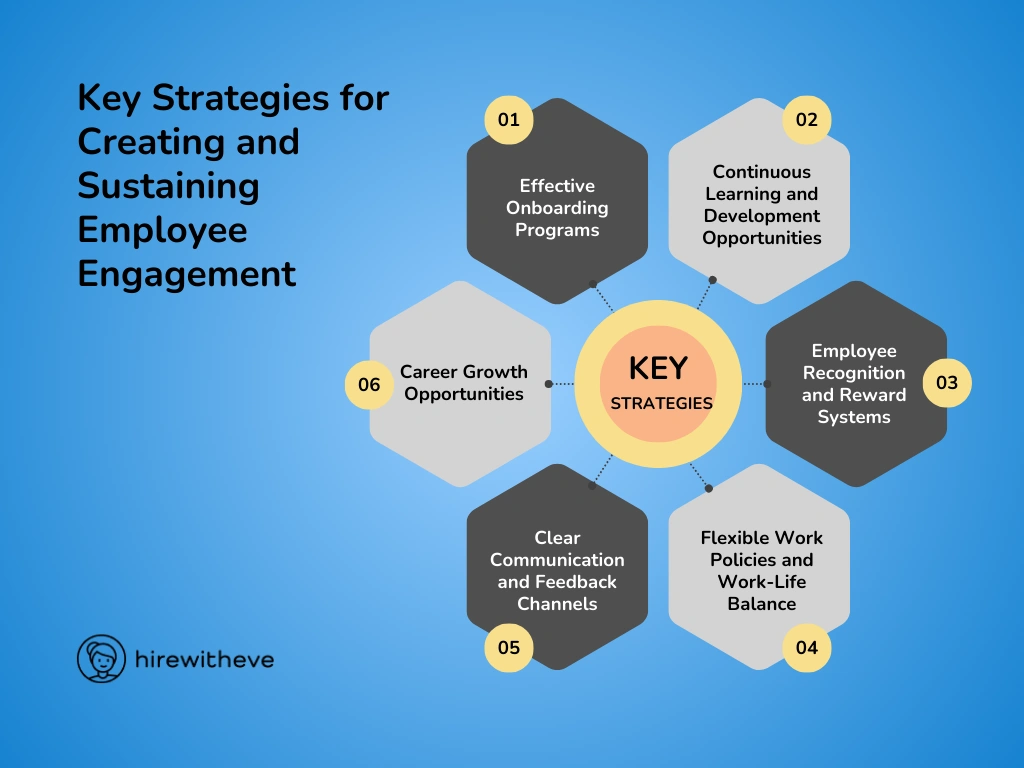Creating and Sustaining Employee Engagement

In today’s competitive business landscape, attracting and retaining top talent is more challenging than ever. Talent acquisition specialists and HR managers are tasked not only with hiring the right candidates but also with ensuring they remain engaged throughout their employment. Creating and sustaining employee engagement through human resource management has emerged as one of the most critical factors in driving organizational success.
By fostering an engaged workforce, companies can experience higher productivity, better retention rates, and overall improved performance. In this blog, we will explore the strategies, tools, and best practices HR professionals can implement to create and sustain employee engagement through human resource management.
The Importance of Employee Engagement
Employee engagement is much more than just employees being satisfied with their jobs; it’s about their emotional and psychological investment in the organization and its success. Engaged employees are enthusiastic about their work, they are proactive, and they take personal responsibility for contributing to organizational goals. They bring innovation, initiative, and energy to their daily tasks, which drives higher productivity levels and overall performance.
Companies with higher engagement levels enjoy numerous benefits:
Increased productivity: Engaged employees tend to go the extra mile to achieve their goals, increasing overall productivity across the organization.
Higher retention rates: When employees feel connected to their work and valued by the organization, they are less likely to look for opportunities elsewhere, reducing costly turnover.
Better customer satisfaction: Engaged employees are more likely to provide excellent service, which leads to improved customer satisfaction and loyalty.
Lower absenteeism: An engaged workforce is more present, both physically and mentally, which means fewer unplanned absences and better attendance rates.
Stronger company culture: A culture of engagement breeds teamwork, trust, and collaboration, which in turn reinforces positive working relationships within the organization.
In today’s highly competitive job market, ensuring high employee engagement is no longer a luxury — it’s a necessity. Human resource management (HRM) plays a pivotal role in creating and sustaining employee engagement through human resource management, and without a structured approach, businesses risk losing their best talent.
The Role of Human Resource Management in Employee Engagement
Human Resource Management (HRM) is at the heart of employee engagement initiatives. HRM is responsible for designing, implementing, and monitoring the strategies that drive employee engagement. While engagement starts at the leadership level, it is HR professionals who ensure that the necessary systems and policies are in place to support the engagement efforts of managers and leaders.
Key roles HRM plays in creating and sustaining employee engagement through human resource management include:
Talent Acquisition: HR’s role in recruiting employees who align with the company’s values and culture is crucial to building an engaged workforce. The right candidates will naturally integrate into the company and contribute positively from day one.
Performance Management: Through effective performance management systems, HRM ensures that employees understand their roles, receive continuous feedback, and are held accountable for their contributions, which fosters engagement.
Learning and Development: By providing continuous learning and development opportunities, HRM helps employees improve their skills, preparing them for future roles and keeping them engaged in their current roles.
Employee Relations: HRM facilitates open communication and resolves conflicts, ensuring that employees feel heard and valued, which is essential for maintaining high levels of engagement.
Workplace Environment: HRM plays a significant role in shaping the work environment by implementing policies that promote work-life balance, inclusivity, and collaboration, all of which contribute to employee engagement.
Through these efforts, HRM becomes the driving force behind creating and sustaining employee engagement through human resource management by crafting an organizational culture that values and supports its workforce.
Key Strategies for Creating and Sustaining Employee Engagement through Human Resource Management
Implementing effective employee engagement strategies is critical to success. Here are some key strategies that HR managers can implement to boost engagement:

Effective Onboarding Programs
The onboarding process is often overlooked as a driver of employee engagement. However, it is one of the first opportunities HR has to connect new hires to the company culture, vision, and values. A well-structured onboarding program can make employees feel valued from day one, which increases the likelihood that they will be engaged in their roles.
Welcoming Environment: Create a welcoming atmosphere that helps new employees feel integrated and part of the team quickly.
Job Role Clarity: Provide clear expectations and responsibilities, reducing confusion and ensuring that new hires know how they contribute to the company’s success.
Cultural Integration: Incorporate activities that immerse employees in the company culture and ensure they understand the mission and values.
Continuous Learning and Development Opportunities
Learning and development programs are crucial for creating and sustaining employee engagement through human resource management. Employees are more likely to stay engaged when they feel they are learning and growing within their roles. HR managers should focus on creating a culture of continuous improvement by offering professional development opportunities that align with the company’s goals and the employee’s career aspirations.
Workshops and Training Programs: Providing employees with learning opportunities not only develops their skills but also shows that the company is invested in their long-term success.
Mentorship and Coaching: Encouraging mentorship and coaching relationships helps employees grow professionally while also fostering deeper engagement within the organization.
Employee Recognition and Reward Systems
Recognition is one of the most powerful tools HR managers have to foster employee engagement. Recognizing and rewarding employees for their efforts can significantly boost morale and motivate individuals to contribute at higher levels. Recognition programs should be timely, transparent, and meaningful to employees to have a lasting impact.
Public Recognition: Recognize employees in front of their peers for outstanding work or contributions.
Tailored Rewards: Personalize rewards based on what matters to individual employees, whether that’s monetary rewards, additional time off, or professional development opportunities.
Flexible Work Policies and Work-Life Balance
Work-life balance has become increasingly important, particularly in a world that is shifting more toward remote work. Flexible work policies are one of the key elements in creating and sustaining employee engagement through human resource management, as they enable employees to balance personal and professional responsibilities without burnout.
Remote Work Options: Allowing employees to work from home when needed shows trust and flexibility, which can boost engagement.
Flexible Schedules: Offering flexible work hours helps employees manage their commitments and reduces stress, making them more engaged and productive at work.
Clear Communication and Feedback Channels
Transparent communication is fundamental to engagement. HR managers should ensure that employees have open channels of communication to express concerns, share ideas, and provide feedback. Creating a culture where feedback is valued and acted upon encourages employees to stay engaged and connected to their roles.
Regular Check-ins: Implementing one-on-one meetings or regular feedback sessions helps keep employees aligned with company goals and engaged in their personal development.
360-Degree Feedback: Allowing employees to give and receive feedback from peers, subordinates, and managers can create a holistic view of performance and foster a culture of continuous improvement.
Career Growth Opportunities
Employees are more engaged when they see opportunities for growth within the company. Career development programs, mentorships, and internal mobility options contribute to creating and sustaining employee engagement through human resource management by providing employees with a clear pathway for advancement.
Internal Promotions: Encourage employees to grow within the organization by offering internal promotions and clear career paths.
Mentorship Programs: Pairing employees with mentors helps them develop the skills necessary for future roles, keeping them engaged and motivated.
HirewithEve Features Overview
HirewithEve offers several key features that align perfectly with today’s needs:
Skills-Based Hiring: HirewithEve emphasizes the importance of hiring based on skills rather than just credentials or past job titles. This approach allows employers to find candidates who are a better fit for specific roles, especially in industries where specific skill sets are crucial.
Remote Hiring Support: Given the shift towards remote work, the platform likely includes features that help companies find and hire the best talent from anywhere worldwide, breaking down geographical barriers.
ATS (Applicant Tracking System) Integration: HirewithEve offers integration with ATS platforms to improve the efficiency of the hiring process, making it easier for HR teams to track and manage candidates.
Analytics and Insights: The platform offers analytics features to provide insights into hiring trends, candidate performance, and the effectiveness of various hiring strategies.
The Impact of Technology on Employee Engagement
In the digital age, technology has revolutionized how companies manage their workforce and has a significant impact on creating and sustaining employee engagement through human resource management. The use of HR technology enables more efficient communication, performance tracking, learning opportunities, and employee recognition, all of which contribute to a more engaged workforce.
Enhanced Communication Tools
Technology allows for better communication between employees and management, especially in remote or hybrid work environments. Tools like video conferencing, instant messaging, and project management software keep teams connected, regardless of their location. This accessibility fosters a sense of belonging and collaboration, which is vital for engagement.
Data-Driven Decision Making
HR technologies provide actionable data that help HR managers understand engagement levels, performance metrics, and employee satisfaction. By leveraging data analytics, HR professionals can identify trends and areas of improvement in engagement strategies, making decisions that directly benefit the workforce.
Automation of HR Processes
Automating administrative tasks, such as payroll, attendance tracking, and benefits management, allows HR professionals to focus more on strategic initiatives that directly impact employee engagement. This shift enables HR teams to spend more time on activities that promote a positive employee experience, such as performance management, employee development, and wellness programs.
Best Practices for Long-Term Employee Engagement
Sustaining long-term employee engagement requires continuous effort from HR managers and a commitment to fostering a culture of engagement throughout the organization. Here are some best practices to ensure employees remain engaged over time:
Consistency in Recognition
Consistent employee recognition is one of the best ways to maintain long-term engagement. Rather than focusing solely on annual performance reviews, HR managers should implement ongoing recognition programs that reward employees for their efforts throughout the year. Acknowledging achievements, both big and small, helps employees feel appreciated and keeps them motivated.
Fostering a Positive Work Culture
A strong company culture that promotes collaboration, respect, and inclusivity is essential for long-term engagement. HR managers should work to create an environment where employees feel valued and where teamwork is encouraged.
Continuous Career Development
Employees who see opportunities for growth and advancement are more likely to remain engaged over the long term. HR professionals should prioritize career development initiatives that align with employee’s aspirations and organizational goals. Regularly revisiting employee’s career paths and offering learning opportunities help maintain enthusiasm and commitment to the company.
Transparent Communication
Maintaining transparency in communication is essential for long-term engagement. HR managers should ensure that employees are informed about company decisions, future goals, and any organizational changes. Open communication builds trust and keeps employees aligned with the company’s vision.
Measuring Employee Engagement Effectively
To ensure that employee engagement efforts are successful, HR managers need to measure engagement levels regularly. Measuring engagement provides insights into what’s working, what needs improvement, and how employees are feeling overall. There are several ways to effectively measure employee engagement:
Employee Engagement Surveys
One of the most common tools for measuring engagement is through employee surveys. These surveys ask questions about job satisfaction, work environment, relationships with colleagues, and perceptions of leadership. The feedback collected from these surveys can be used to implement improvements in areas where engagement is lacking.
Pulse Surveys
In addition to annual or bi-annual engagement surveys, pulse surveys are shorter and more frequent check-ins that allow HR managers to gauge engagement levels in real time. These surveys are often used to measure employee sentiment on specific issues, such as workload, communication, or management changes.
One-on-One Meetings
Regular one-on-one meetings between employees and their managers can provide a more personal perspective on engagement. These meetings allow employees to discuss any challenges they are facing and provide feedback on their experience within the organization.
Turnover and Retention Rates
Employee turnover and retention rates can be key indicators of engagement levels. High turnover rates often point to low engagement, whereas higher retention rates suggest that employees feel connected to the organization and are committed to staying.
Conclusion
In conclusion, creating and sustaining employee engagement through human resource management is a strategic initiative that requires ongoing effort and commitment from HR professionals. Engaged employees are essential for any organization that aims to remain competitive in today’s fast-paced business environment. By implementing the strategies outlined in this blog and continuously refining them based on feedback and data, HR managers can foster a culture of engagement that leads to higher productivity, stronger employee retention, and overall organizational success.

4 thoughts on “Creating and Sustaining Employee Engagement”